lexus LC500C 2021 Owner's Manual / LEXUS 2021 LC500 CONVERTIBLE OWNER'S MANUAL (OM11498U)
Manufacturer: LEXUS, Model Year: 2021, Model line: LC500C, Model: Lexus LC500C 2021Pages: 410, PDF Size: 8.71 MB
Page 131 of 410
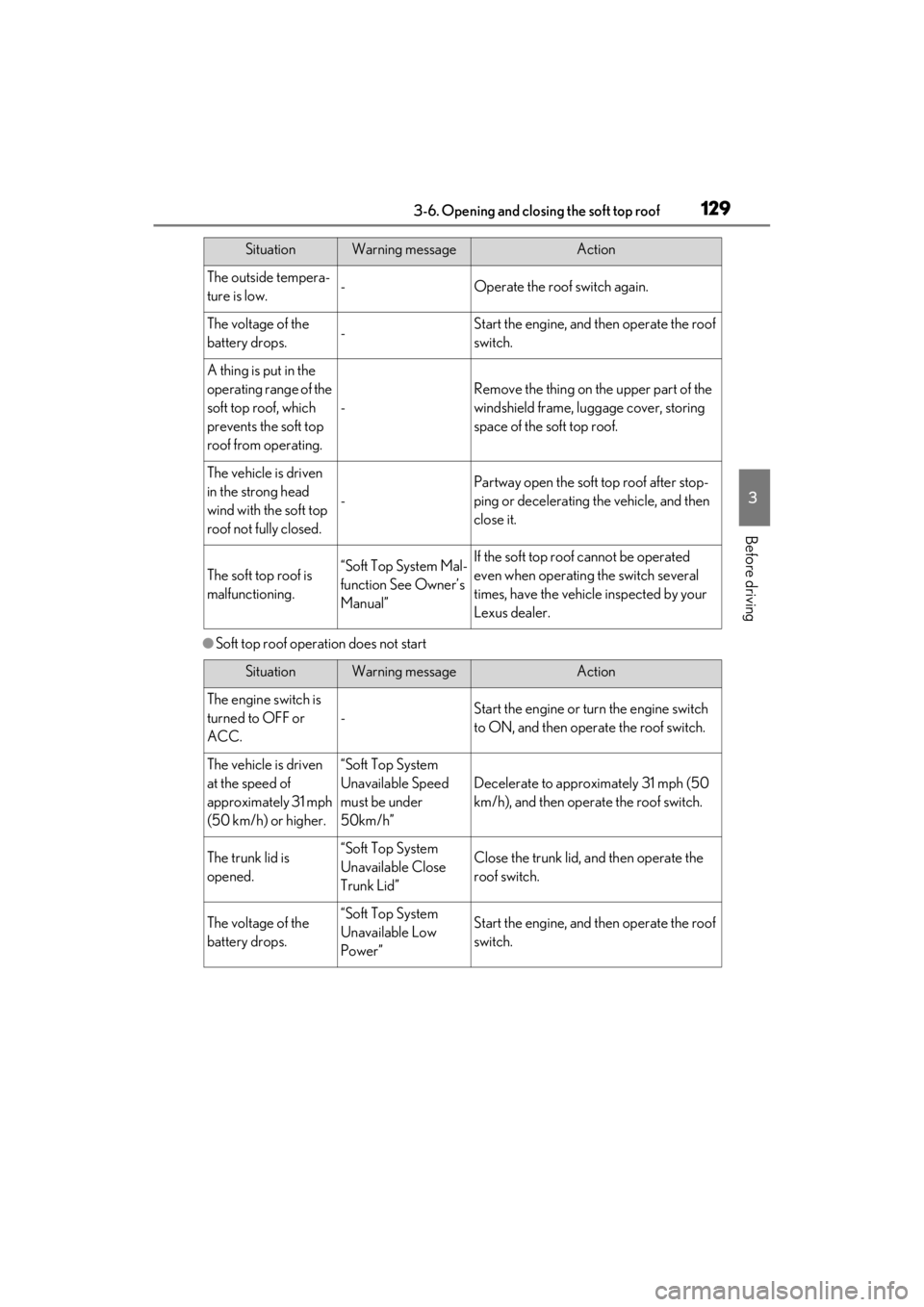
1293-6. Opening and closing the soft top roof
3
Before driving
●Soft top roof operation does not start
The outside tempera-
ture is low.-Operate the roof switch again.
The voltage of the
battery drops.-Start the engine, and then operate the roof
switch.
A thing is put in the
operating range of the
soft top roof, which
prevents the soft top
roof from operating.
-
Remove the thing on the upper part of the
windshield frame, luggage cover, storing
space of the soft top roof.
The vehicle is driven
in the strong head
wind with the soft top
roof not fully closed.
-
Partway open the soft top roof after stop-
ping or decelerating the vehicle, and then
close it.
The soft top roof is
malfunctioning.“Soft Top System Mal-
function See Owner’s
Manual”If the soft top roof cannot be operated
even when operating the switch several
times, have the vehicle inspected by your
Lexus dealer.
SituationWarning messageAction
The engine switch is
turned to OFF or
ACC.
-Start the engine or tu rn the engine switch
to ON, and then operate the roof switch.
The vehicle is driven
at the speed of
approximately 31 mph
(50 km/h) or higher.“Soft Top System
Unavailable Speed
must be under
50km/h”
Decelerate to approximately 31 mph (50
km/h), and then operate the roof switch.
The trunk lid is
opened.“Soft Top System
Unavailable Close
Trunk Lid”Close the trunk lid, and then operate the
roof switch.
The voltage of the
battery drops.“Soft Top System
Unavailable Low
Power”Start the engine, and then operate the roof
switch.
SituationWarning messageAction
Page 132 of 410
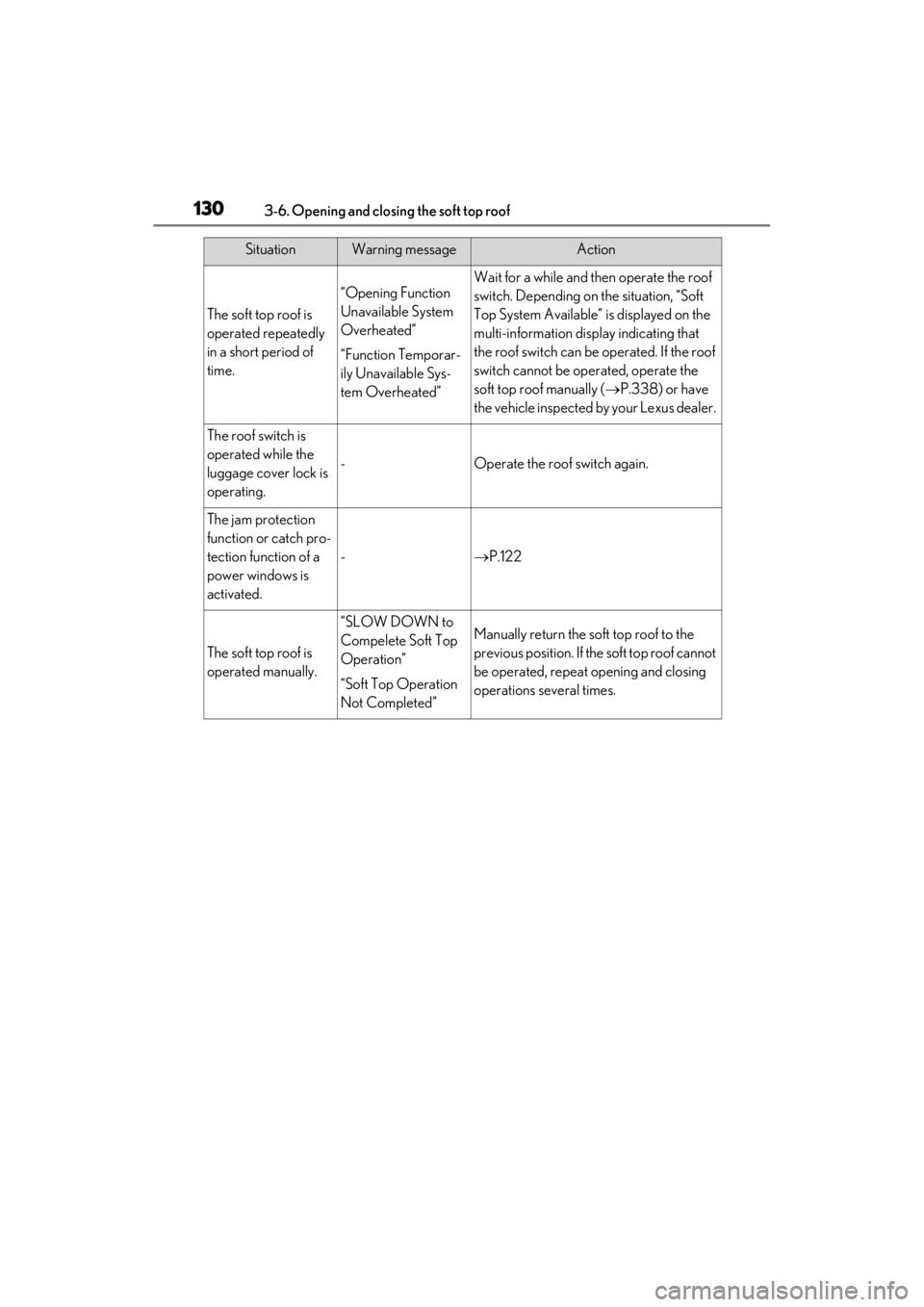
1303-6. Opening and closing the soft top roof
The soft top roof is
operated repeatedly
in a short period of
time.
“Opening Function
Unavailable System
Overheated”
“Function Temporar-
ily Unavailable Sys-
tem Overheated”Wait for a while and then operate the roof
switch. Depending on the situation, “Soft
Top System Available” is displayed on the
multi-information disp lay indicating that
the roof switch can be operated. If the roof
switch cannot be operated, operate the
soft top roof manually ( P.338) or have
the vehicle inspected by your Lexus dealer.
The roof switch is
operated while the
luggage cover lock is
operating.
-Operate the roof switch again.
The jam protection
function or catch pro-
tection function of a
power windows is
activated.
- P.122
The soft top roof is
operated manually.
“SLOW DOWN to
Compelete Soft Top
Operation”
“Soft Top Operation
Not Completed”Manually return the soft top roof to the
previous position. If the soft top roof cannot
be operated, repeat opening and closing
operations several times.
SituationWarning messageAction
Page 133 of 410
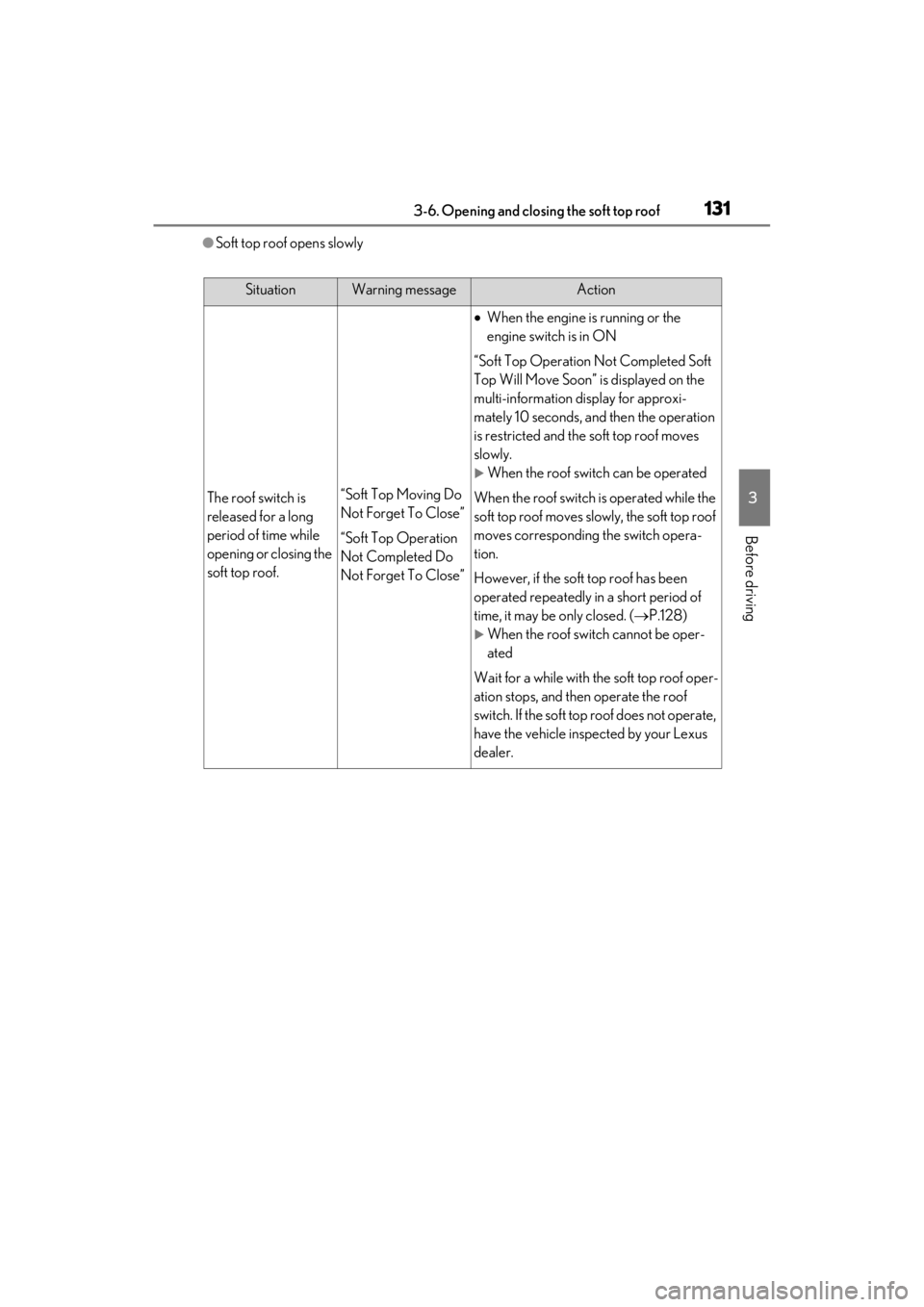
1313-6. Opening and closing the soft top roof
3
Before driving
●Soft top roof opens slowly
SituationWarning messageAction
The roof switch is
released for a long
period of time while
opening or closing the
soft top roof.“Soft Top Moving Do
Not Forget To Close”
“Soft Top Operation
Not Completed Do
Not Forget To Close”
When the engine is running or the
engine switch is in ON
“Soft Top Operation Not Completed Soft
Top Will Move Soon” is displayed on the
multi-information display for approxi-
mately 10 seconds, and then the operation
is restricted and the soft top roof moves
slowly.
When the roof switch can be operated
When the roof switch is operated while the
soft top roof moves slowly, the soft top roof
moves corresponding the switch opera-
tion.
However, if the soft top roof has been
operated repeatedly in a short period of
time, it may be only closed. ( P.128)
When the roof switch cannot be oper-
ated
Wait for a while with the soft top roof oper-
ation stops, and then operate the roof
switch. If the soft top roof does not operate,
have the vehicle inspected by your Lexus
dealer.
Page 134 of 410
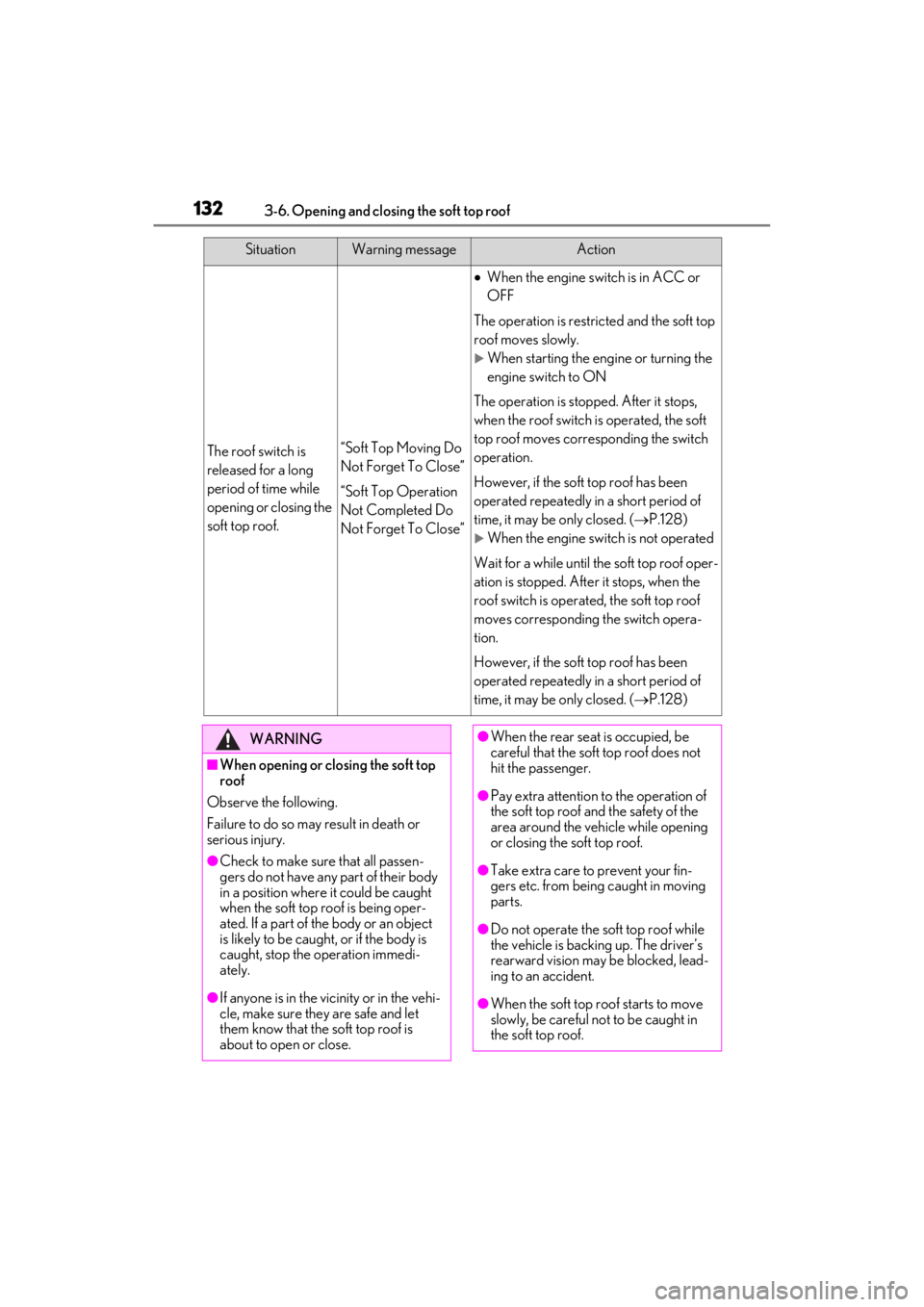
1323-6. Opening and closing the soft top roof
The roof switch is
released for a long
period of time while
opening or closing the
soft top roof.“Soft Top Moving Do
Not Forget To Close”
“Soft Top Operation
Not Completed Do
Not Forget To Close”
When the engine switch is in ACC or
OFF
The operation is restricted and the soft top
roof moves slowly.
When starting the engine or turning the
engine switch to ON
The operation is stoppe d. After it stops,
when the roof switch is operated, the soft
top roof moves corresponding the switch
operation.
However, if the soft top roof has been
operated repeatedly in a short period of
time, it may be only closed. ( P.128)
When the engine switch is not operated
Wait for a while until the soft top roof oper-
ation is stopped. After it stops, when the
roof switch is operated, the soft top roof
moves corresponding the switch opera-
tion.
However, if the soft top roof has been
operated repeatedly in a short period of
time, it may be only closed. ( P.128)
SituationWarning messageAction
WARNING
■When opening or closing the soft top
roof
Observe the following.
Failure to do so may result in death or
serious injury.
●Check to make sure that all passen-
gers do not have any part of their body
in a position where it could be caught
when the soft top roof is being oper-
ated. If a part of the body or an object
is likely to be caught, or if the body is
caught, stop the operation immedi-
ately.
●If anyone is in the vi cinity or in the vehi-
cle, make sure they are safe and let
them know that the soft top roof is
about to open or close.
●When the rear seat is occupied, be
careful that the soft top roof does not
hit the passenger.
●Pay extra attention to the operation of
the soft top roof and the safety of the
area around the vehicle while opening
or closing the soft top roof.
●Take extra care to prevent your fin-
gers etc. from being caught in moving
parts.
●Do not operate the soft top roof while
the vehicle is backing up. The driver’s
rearward vision may be blocked, lead-
ing to an accident.
●When the soft top roof starts to move
slowly, be careful no t to be caught in
the soft top roof.
Page 135 of 410
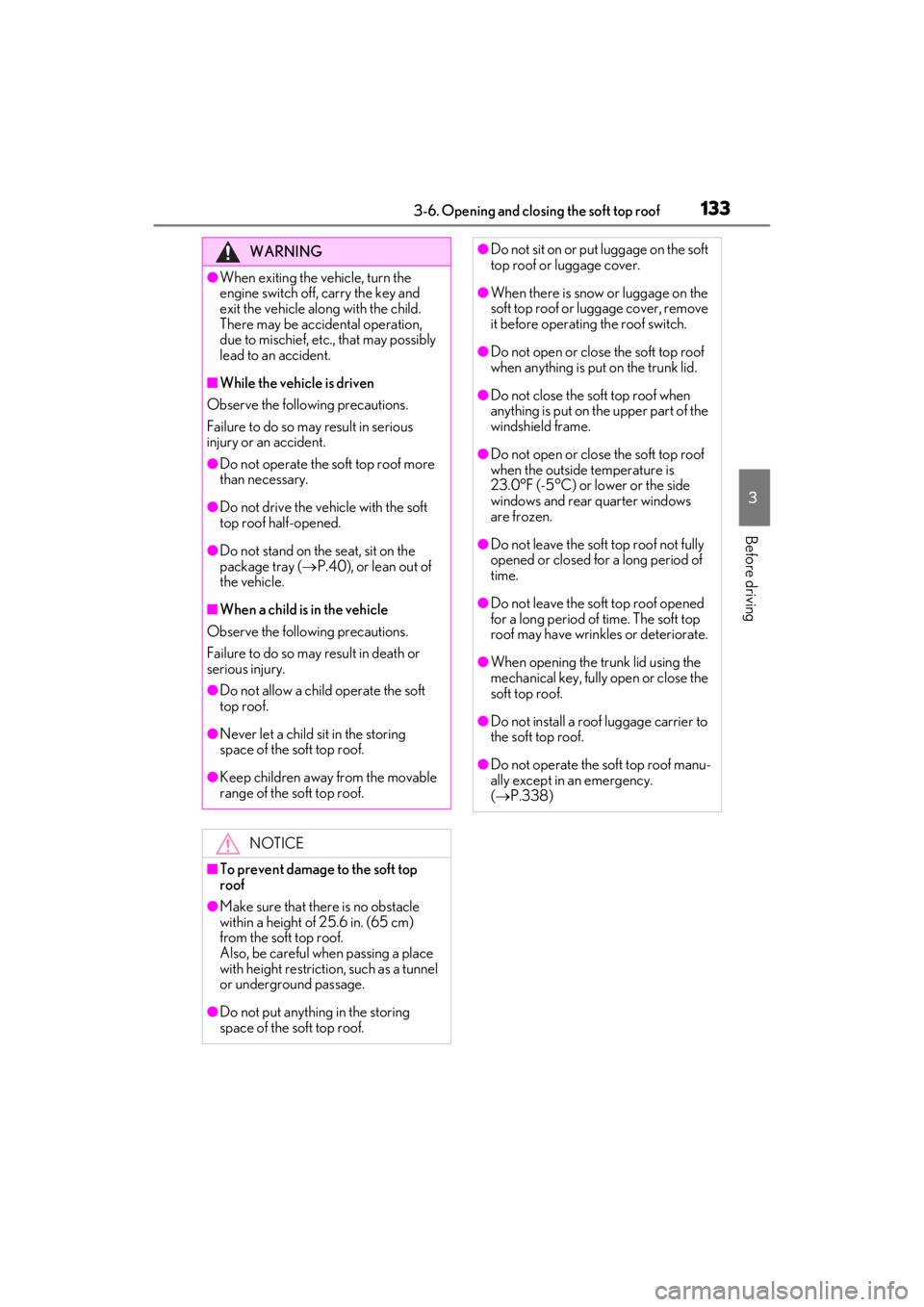
1333-6. Opening and closing the soft top roof
3
Before driving
WARNING
●When exiting the vehicle, turn the
engine switch off, carry the key and
exit the vehicle along with the child.
There may be accidental operation,
due to mischief, etc., that may possibly
lead to an accident.
■While the vehicle is driven
Observe the following precautions.
Failure to do so may result in serious
injury or an accident.
●Do not operate the soft top roof more
than necessary.
●Do not drive the vehicle with the soft
top roof half-opened.
●Do not stand on the seat, sit on the
package tray ( P.40), or lean out of
the vehicle.
■When a child is in the vehicle
Observe the following precautions.
Failure to do so may result in death or
serious injury.
●Do not allow a child operate the soft
top roof.
●Never let a child sit in the storing
space of the soft top roof.
●Keep children away from the movable
range of the soft top roof.
NOTICE
■To prevent damage to the soft top
roof
●Make sure that ther e is no obstacle
within a height of 25.6 in. (65 cm)
from the soft top roof.
Also, be careful when passing a place
with height restriction, such as a tunnel
or underground passage.
●Do not put anything in the storing
space of the soft top roof.
●Do not sit on or put luggage on the soft
top roof or luggage cover.
●When there is snow or luggage on the
soft top roof or luggage cover, remove
it before operating the roof switch.
●Do not open or close the soft top roof
when anything is put on the trunk lid.
●Do not close the soft top roof when
anything is put on the upper part of the
windshield frame.
●Do not open or close the soft top roof
when the outside temperature is
23.0°F (-5°C) or lower or the side
windows and rear quarter windows
are frozen.
●Do not leave the soft top roof not fully
opened or closed for a long period of
time.
●Do not leave the soft top roof opened
for a long period of time. The soft top
roof may have wrinkles or deteriorate.
●When opening the trunk lid using the
mechanical key, full y open or close the
soft top roof.
●Do not install a roof luggage carrier to
the soft top roof.
●Do not operate the soft top roof manu-
ally except in an emergency.
( P.338)
Page 136 of 410

1343-6. Opening and closing the soft top roof
Page 137 of 410

135
4
4
Driving
Driving
4-1. Before drivingDriving the vehicle ..................... 136
Cargo and luggage ................... 142
Vehicle load limits ...................... 144
Trailer towing ............................... 144
Dinghy towing ............................. 145
4-2. Driving procedures Engine (ignition) switch ........... 146
Automatic transmission........... 150
Turn signal lever.......................... 156
Parking brake .............................. 157
Brake Hold.................................... 159
4-3. Operating the lights and wipers Headlight switch .......................... 161
Automatic High Beam ............. 164
Windshield wipers and washer ......................................................... 167
4-4. Refueling Opening the fuel tank cap....... 171
4-5. Using the driving support sys- tems
Lexus Safety System + ............. 173
PCS (Pre-Collision System).. 179
LKA (Lane-Keeping Assist) .. 186
Dynamic radar cruise control with full-speed range....................... 194
Driving mode select switch... 203
Intuitive parking assist ............. 204
BSM (Blind Spot Monitor) .... 209
Driving assist systems ............... 2184-6. Driving tips
Winter driving tips .................... 223
Page 138 of 410

1364-1. Before driving
4-1.Before driving
■Starting the engine
P.146
■Driving
1 With the brake pedal depressed,
shift the shift position to D.
(P.152)
Check that the shift position indicator
shows D.
2 If the parking brake is in manual
mode, release the parking brake.
(P.157)
3 Gradually release the brake pedal
and gently depress the accelerator
pedal to accelerate the vehicle.
■Stopping
1 With the shift position in D, depress
the brake pedal.
2 If necessary, set the parking brake.
If the vehicle is to be stopped for an
extended period of time, shift the shift posi-
tion to P. ( P.152)
■Parking the vehicle
1 Stop the vehicle completely.
2 If the parking brake is in manual
mode, set the parking brake.
(P.157)
3 Shift the shift position to P.
(P.152)
Check that the shift position indicator
shows P.
4 Press the engine switch to stop the
engine.
5 Slowly release the brake pedal.
6 Lock the door, making sure that
you have the electronic key on your
person.
If parking on a hill, block the wheels as
needed.
■Starting off on a steep uphill
1 Firmly depress the brake pedal and
shift the shift position to D.
The hill-start assist control will be activated.
( P.219)
2 Set the parking brake. ( P.157)
3 Release the brake pedal and gently
depress the accelerator pedal to
accelerate the vehicle.
4 Release the parking brake.
(P.157)
■When parking the vehicle
In order to prevent theft or effect of the
weather on the environment of the vehicle
cabin, close the soft top roof when parking
the vehicle.
■Driving in the rain
●Drive carefully when it is raining, because
visibility will be reduced, the windows
may become fogged-up, and the road
will be slippery.
●Drive carefully when it starts to rain,
because the road surface will be espe-
cially slippery.
●Refrain from high speeds when driving on
an expressway in the rain, because there
may be a layer of wa ter between the tires
and the road surface, preventing the
steering and brakes from operating
properly.
■Engine speed while driving
In the following conditions, the engine
speed may become high while driving. This
Driving the vehicle
The following procedures should be
observed to ensure safe driving:
Driving procedure
Page 139 of 410

1374-1. Before driving
4
Driving
is due to automatic up-shifting control or
down-shifting implementation to meet driv-
ing conditions. It does not indicate sudden
acceleration.
●The vehicle is judged to be driving uphill
or downhill
●When the accelerator pedal is released
●When the brake pedal is firmly or quickly
depressed
■Restraining the engine output (Brake
Override System)
●When the accelerator and brake pedals
are depressed at the same time, the
engine output may be restrained.
●A warning message is displayed on the
multi-information display while the sys-
tem is operating. If a warning message is
shown on the multi-information display,
read the message and follow the instruc-
tions.
■Restraining sudden start (Drive-Start
Control)
●When the following unusual operation is
performed, the engine output may be
restrained.
• When the shift position is shifted from R
to D, D to R, N to R, P to D
*, or P to R* (D
includes M) with the accelerator pedal
depressed, a warning message appears
on the multi-information display. If a
warning message is shown on the multi-
information display, read the message
and follow the instructions.
• When the accelerator pedal is depressed
too much while the vehicle is in reverse.
*: Depending on the situation, the shift posi-
tion may not be changed.
●While Drive-Start Control is being acti-
vated, your vehicle may have trouble
escaping from the mud or fresh snow. In
such case, deactivate TRAC ( P.219) to
cancel Drive-Start Control so that the
vehicle may become able to escape from
the mud or fresh snow.
■Breaking in your new Lexus
To extend the life of the vehicle, observing
the following precautions is recommended:
●For the first 186 miles (300 km): Avoid sudden stops.
●For the first 621 miles (1000 km):
• Do not drive at extremely high speeds.
• Avoid sudden acceleration.
• Do not drive continuously in low gears.
• Do not drive at a constant speed for extended periods.
■Drum-in-disc type parking brake sys-
tem
Your vehicle has a drum-in-disc type park-
ing brake system. This type of brake system
needs bedding-down of the brake shoes
periodically or whenever the parking brake
shoes and/or drum are replaced. Have
your Lexus dealer perform the bedding
down operation.
■Operating your vehicle in a foreign
country
Comply with the relevant vehicle registra-
tion laws and confirm the availability of the
correct fuel. ( P.351)
WARNING
Observe the following precautions.
Failure to do so may result in death or
serious injury.
■When starting the vehicle
Always keep your foot on the brake
pedal while stopped with the engine run-
ning. This prevents the vehicle from
creeping.
Page 140 of 410

1384-1. Before driving
WARNING
■When driving the vehicle
●Do not drive if you are unfamiliar with
the location of the brake and accelera-
tor pedals to avoid depressing the
wrong pedal.
• Accidentally depressing the accelera- tor pedal instead of the brake pedal
will result in sudden acceleration that
may lead to an accident.
• When backing up, you may twist your body around, leading to a difficulty in
operating the pedals. Make sure to
operate the pedals properly.
• Make sure to keep a correct driving posture even when moving the vehicle
only slightly. This allows you to depress
the brake and accelerator pedals
properly.
• Depress the brake pedal using your right foot. Depressing the brake pedal
using your left foot may delay
response in an emergency, resulting in
an accident.
●Do not drive the vehicle over or stop
the vehicle near flammable materials.
The exhaust system and exhaust gases
can be extremely hot. These hot parts
may cause a fire if there is any flamma-
ble material nearby.
●During normal driving, do not turn off
the engine. Turning the engine off
while driving will not cause loss of
steering or braking control, however,
power assist to the steering will be lost.
This will make it more difficult to steer
smoothly, so you should pull over and
stop the vehicle as soon as it is safe to
do so.
In the event of an emergency, such as
if it becomes impo ssible to stop the
vehicle in the normal way: P.306
●Use engine braking (downshift) to
maintain a safe speed when driving
down a steep hill.
Using the brakes continuously may
cause the brakes to overheat and lose
effectiveness. ( P.150)
●Do not adjust the positions of the
steering wheel, the seat, or the inside
or outside rear view mirrors while driv-
ing.
Doing so may result in a loss of vehicle
control.
●Always check that all passengers’
arms, heads or other parts of their
body are not outside the vehicle.
●Do not drive in excess of the speed
limit. Even if the legal speed limit per-
mits it, do not drive over 85 mph (140
km/h) unless your vehicle has high-
speed capability tires. Driving over 85
mph (140 km/h) may result in tire fail-
ure, loss of control and possible injury.
Be sure to consult a tire dealer to
determine whether the tires on your
vehicle are high-speed capability tires
or not before driving at such speeds.
■When driving on slippery road sur-
faces
●Sudden braking, acceleration and
steering may cause tire slippage and
reduce your ability to control the vehi-
cle.
●Sudden acceleration, engine braking
due to shifting, or changes in engine
speed could cause the vehicle to skid,
resulting in an accident.
●After driving through a puddle, lightly
depress the brake pedal to make sure
that the brakes are functioning prop-
erly. Wet brake pads may prevent the
brakes from functioning properly. If
the brakes on only one side are wet
and not functioning properly, steering
control may be affected.
■When shifting the shift position
●Do not let the vehicle roll backward
while a forward driving position is
selected, or roll forw ard while the shift
position is in R.
Doing so may cause the engine to stall
or lead to poor brake and steering
performance, resulting in an accident
or damage to the vehicle.